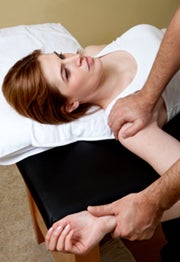Rotator Cuff Repair

The shoulder is the most flexible joint in the body. It can move in multiple directions so that you can lift, push and pull. Because the shoulder is used thousands of times during the day, it can over time develop problems. The joint is comprised of three bones — the upper arm bone or humerus, the shoulder blade or scapula and the collarbone or clavicle.
The humerus fits into a socket, which is surrounded by cartilage that covers the surface of the ball and socket. The joint is encased in ligaments and a membrane that produces fluid that lubricates the joint. The rotator cuff made of four tendons that keep the arm bone centered in the socket. The tendon is called the rotator cuff, which covers the head of the arm bone and attaches to the shoulder blade. Between the rotator cuff and bone is a bursa, which helps the tendons move smoothly.
When the shoulder undergoes an injury or has a painful condition that does not respond to conservative, nonsurgical treatment, arthroscopy is recommended. Many times the shoulder develops problems from overuse and age-related wear and tear. When this occurs, the joint becomes inflamed, stiff and uncomfortable. In some cases, the shoulder may lose mobility.
Our WakeMed Orthopaedic Surgical Team
Our surgeons use a variety of minimally-invasive, state-of-the-art techniques to repair torn tissue that result from sports-related or occupational injuries.
WakeMed surgeons can perform open repair procedures for more serious injuries as well as arthroscopic procedures that use small cameras inserted into the shoulder allowing the surgeon to perform micro repairs to damaged tissue.
Many patients can benefit from minimally invasive procedures to fix damaged rotator cuffs.
Types of Rotator Cuff Repairs
Arthroscopy
Arthroscopy — a minimally invasive procedure that can help accurately diagnose and repair shoulder problems — is the gold standard in treating an injured or diseased shoulder joint. Shoulder arthroscopy is helpful in repairing rotator cuff tendons, shoulder instability and other soft tissue repairs.
Under general anesthesia, the surgeon injects fluid into the shoulder joint. This fluid clears the joint so that the structures are easily seen through the arthroscope (lighted camera). A very small incision is made and the fiber optic camera is inserted into the joint. Images are projected onto a monitor to help guide the surgeon through the procedure. Other small incisions are made for the instruments that will be used to make any repairs.
Torn Rotator Cuff Repair
To repair a torn rotator cuff, the surgeon reattaches the tendon to the head of the bone arm. If the cuff is totally torn, the thickest section is sewn together to provide stability. If the tear is partial, you may only need to have the tendon trimmed or smoothed. If there are other shoulder issues, such as bone spurs or torn cartilage, the surgeon may be able to also make the repairs.
Chronic Shoulder Instability
Since the shoulder is the most flexible joint in the body, movement over time can result in instability. This happens when the humerus comes out the socket — either through sudden injury or trauma, repetitive motion resulting in lose ligament or from multidirectional overuse.
When the dislocation happens consistently, you have chronic shoulder instability. The pain and discomfort can be treated nonsurgically, but surgery is the best option for long-term success. By using arthroscopy, the surgeon can suture and repair the torn or loose ligaments so that the shoulder is held in place.